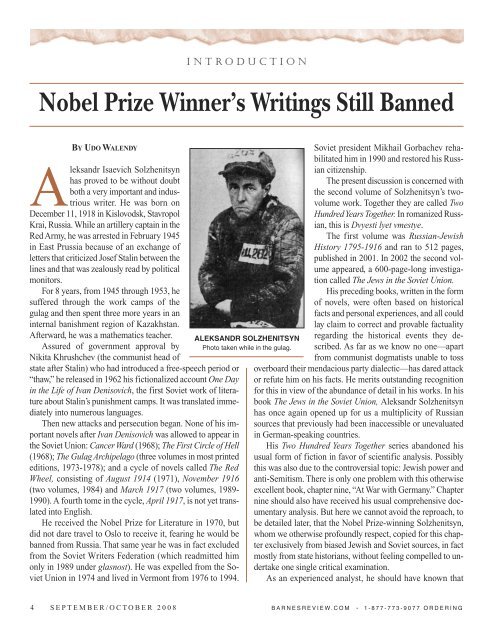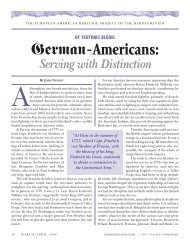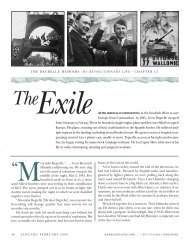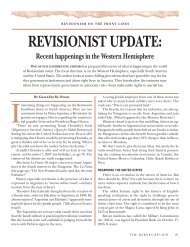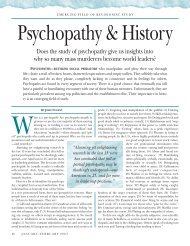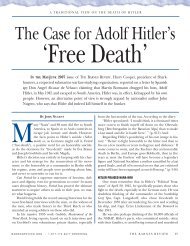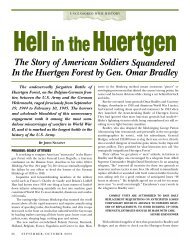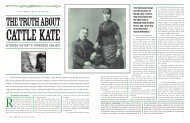Russia and the Jews
Russia and the Jews
Russia and the Jews
Create successful ePaper yourself
Turn your PDF publications into a flip-book with our unique Google optimized e-Paper software.
I N T R O D U C T I O N<br />
Nobel Prize Winner’s Writings Still Banned<br />
BY UDO WALENDY<br />
Aleks<strong>and</strong>r Isaevich Solzhenitsyn<br />
has proved to be without doubt<br />
both a very important <strong>and</strong> industrious<br />
writer. He was born on<br />
December 11, 1918 in Kislovodsk, Stavropol<br />
Krai, <strong>Russia</strong>. While an artillery captain in <strong>the</strong><br />
Red Army, he was arrested in February 1945<br />
in East Prussia because of an exchange of<br />
letters that criticized Josef Stalin between <strong>the</strong><br />
lines <strong>and</strong> that was zealously read by political<br />
monitors.<br />
For 8 years, from 1945 through 1953, he<br />
suffered through <strong>the</strong> work camps of <strong>the</strong><br />
gulag <strong>and</strong> <strong>the</strong>n spent three more years in an<br />
internal banishment region of Kazakhstan.<br />
Afterward, he was a ma<strong>the</strong>matics teacher.<br />
Assured of government approval by<br />
Nikita Khrushchev (<strong>the</strong> communist head of<br />
state after Stalin) who had introduced a free-speech period or<br />
“thaw,” he released in 1962 his fictionalized account One Day<br />
in <strong>the</strong> Life of Ivan Denisovich, <strong>the</strong> first Soviet work of literature<br />
about Stalin’s punishment camps. It was translated immediately<br />
into numerous languages.<br />
Then new attacks <strong>and</strong> persecution began. None of his important<br />
novels after Ivan Denisovich was allowed to appear in<br />
<strong>the</strong> Soviet Union: CancerWard (1968); The First Circle of Hell<br />
(1968); The Gulag Archipelago (three volumes in most printed<br />
editions, 1973-1978); <strong>and</strong> a cycle of novels called The Red<br />
Wheel, consisting of August 1914 (1971), November 1916<br />
(two volumes, 1984) <strong>and</strong> March 1917 (two volumes, 1989-<br />
1990). A fourth tome in <strong>the</strong> cycle, April 1917, is not yet translated<br />
into English.<br />
He received <strong>the</strong> Nobel Prize for Literature in 1970, but<br />
did not dare travel to Oslo to receive it, fearing he would be<br />
banned from <strong>Russia</strong>. That same year he was in fact excluded<br />
from <strong>the</strong> Soviet Writers Federation (which readmitted him<br />
only in 1989 under glasnost). He was expelled from <strong>the</strong> Soviet<br />
Union in 1974 <strong>and</strong> lived in Vermont from 1976 to 1994.<br />
ALEKSANDR SOLZHENITSYN<br />
Photo taken while in <strong>the</strong> gulag.<br />
Soviet president Mikhail Gorbachev rehabilitated<br />
him in 1990 <strong>and</strong> restored his <strong>Russia</strong>n<br />
citizenship.<br />
The present discussion is concerned with<br />
<strong>the</strong> second volume of Solzhenitsyn’s twovolume<br />
work. Toge<strong>the</strong>r <strong>the</strong>y are called Two<br />
HundredYears Toge<strong>the</strong>r. In romanized <strong>Russia</strong>n,<br />
this is Dvyesti lyet vmestye.<br />
The first volume was <strong>Russia</strong>n-Jewish<br />
History 1795-1916 <strong>and</strong> ran to 512 pages,<br />
published in 2001. In 2002 <strong>the</strong> second volume<br />
appeared, a 600-page-long investigation<br />
called The <strong>Jews</strong> in <strong>the</strong> Soviet Union.<br />
His preceding books, written in <strong>the</strong> form<br />
of novels, were often based on historical<br />
facts <strong>and</strong> personal experiences, <strong>and</strong> all could<br />
lay claim to correct <strong>and</strong> provable factuality<br />
regarding <strong>the</strong> historical events <strong>the</strong>y described.<br />
As far as we know no one—apart<br />
from communist dogmatists unable to toss<br />
overboard <strong>the</strong>ir mendacious party dialectic—has dared attack<br />
or refute him on his facts. He merits outst<strong>and</strong>ing recognition<br />
for this in view of <strong>the</strong> abundance of detail in his works. In his<br />
book The <strong>Jews</strong> in <strong>the</strong> Soviet Union, Aleks<strong>and</strong>r Solzhenitsyn<br />
has once again opened up for us a multiplicity of <strong>Russia</strong>n<br />
sources that previously had been inaccessible or unevaluated<br />
in German-speaking countries.<br />
His Two Hundred Years Toge<strong>the</strong>r series ab<strong>and</strong>oned his<br />
usual form of fiction in favor of scientific analysis. Possibly<br />
this was also due to <strong>the</strong> controversial topic: Jewish power <strong>and</strong><br />
anti-Semitism. There is only one problem with this o<strong>the</strong>rwise<br />
excellent book, chapter nine, “At War with Germany.” Chapter<br />
nine should also have received his usual comprehensive documentary<br />
analysis. But here we cannot avoid <strong>the</strong> reproach, to<br />
be detailed later, that <strong>the</strong> Nobel Prize-winning Solzhenitsyn,<br />
whom we o<strong>the</strong>rwise profoundly respect, copied for this chapter<br />
exclusively from biased Jewish <strong>and</strong> Soviet sources, in fact<br />
mostly from state historians, without feeling compelled to undertake<br />
one single critical examination.<br />
As an experienced analyst, he should have known that<br />
4 S E P T E M B E R / O C T O B E R 2 0 0 8 B A R N E S R E V I E W . C O M • 1 - 8 7 7 - 7 7 3 - 9 0 7 7 O R D E R I N G


